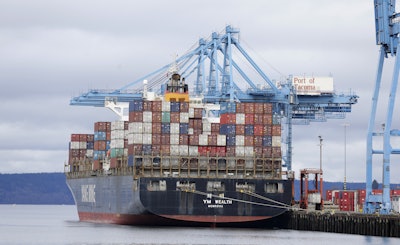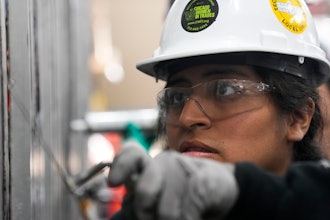
LOS ANGELES (AP) — Dockworkers along the West Coast began the monthslong task Saturday of clearing seaports of cargo that was caught up in a contract feud between their union and employers.
Parked off the Southern California coast is a flotilla of ships bulging with thousands of tractor-trailer sized containers that hold a shopper's delight of goods — which already would be on store shelves but for a labor dispute that has disrupted international trade.
The leader of the Port of Los Angeles, the nation's largest, said it would take three months "to get back a sense of normalcy."
The volume of cargo that West Coast dockworkers and their employers must clear, now that they've reached a tentative contract agreement Friday evening, is staggering. Put in a line, the containers would stretch 579 miles. Stacked up, they'd rise nearly 250 miles — about the orbiting altitude of the International Space Station.
And those are just the ships waiting for dock space at the ports of Los Angeles and Long Beach. There are smaller, though substantial, backups in San Francisco Bay and Washington's Puget Sound. The Port of Oakland reckoned it would take up to eight weeks to recover.
With labor peace restored to the West Coast waterfront, dockworkers did something Saturday evening that they have not for weeks — get to work loading and unloading the massive ocean-going vessels.
In recent weeks, companies that operate marine terminals cut night, weekend and holiday shifts — saying they did not want to pay overtime for what amounted to a "strike with pay." That was a reference to what they said was a worker slowdown that began in November. The union said longshoremen were abiding by all safety rules.
It was the kind of brinksmanship familiar from past negotiations between two sides with a history of conflict that dates to the killing of striking dockworkers during the Great Depression.
While the ports never shut down fully, the problems in the supply chain were acute — and growing. All told,West Coast ports handle about $1 trillion worth of cargo annually.
The contract deal will, eventually, restore the free flow of cargo across docks at 29 seaports that handle about one-quarter of U.S. international trade.
The task facing workers Saturday was immense.
While there are about 30 ships anchored just off the coast awaiting dock space — a visual reminder of the extent of the backlog — there are perhaps two dozen more hanging beyond the horizon and still more slogging across the Pacific, said Gene Seroka, executive director of the Port of Los Angeles.
U.S. exports, particularly from farms, also are waiting to reach Asian markets.
Seroka wants to prioritize ships serving U.S. military bases on the Pacific Rim or carrying perishables such as produce, autos or goods for major retailers.
"The sense of urgency in the industry right now is as good as I've ever seen it," Seroka said of both sides' willingness to speed cargo into the stream of commerce.
On Saturday morning, smaller work crews were preparing dockside yards for a return to bigger crews in the evening. The contract was settled too late Friday to order day crane crews to load and unload ships. In the late afternoon, larger crews gathered at the hiring halls where many longshoremen get their work assignments — though as a ramp-up back to night work, Los Angeles and Long Beach were not yet operating at full capacity.
"I suspect that people will be getting a lot of overtime in the days ahead," said U.S. Labor Secretary Thomas Perez, whom President Obama dispatched to San Francisco this week to push negotiators to a resolution after nine months of bargaining.
The tentative contract still must be approved by the 13,000-member International Longshore and Warehouse Union's rank-and-file, as well as the full Pacific Maritime Association of employers.
A vote by union members could come in April. It was not immediately clear when employers would vote.
Neither side released details, but in a recent letter, maritime association President James McKenna outlined what he called employers' "last, best and final" offer. It included maintenance of nearly no-cost health coverage, an $11,000 increase in the maximum pension benefit to $91,000, and a $1-per-hour wage increase over each of the five years.
Though dockworker wages vary by job and skill level, the average exceeds $50 per hour, according to the maritime association, which represents ocean-going shipping lines and the companies that load and unload cargo at port terminals.
The union's ability to win white-collar wages and benefits for blue-collar work reflects a clout far beyond its numbers.
That power come from several things that founding father Harry Bridges enshrined both in the union's culture and its contract with employers after those killings in 1934.
For one, the contract covers all West Coast ports — if dockworkers want to gain leverage by slowing the flow of cargo, shipping lines have no easy alternatives. Second, the union controls and spreads around job assignments, through hiring halls in each port area.
"That's the power of the ILWU," said Dave Arian, who worked at the docks for 44 years and now runs the union-supported Harry Bridges Institute, a nonprofit that educates workers on labor history. "A small workforce with the ability to shut down the entire West Coast."






















